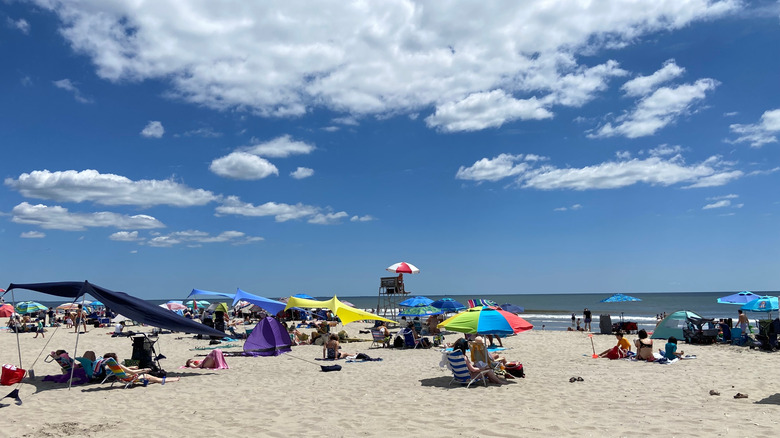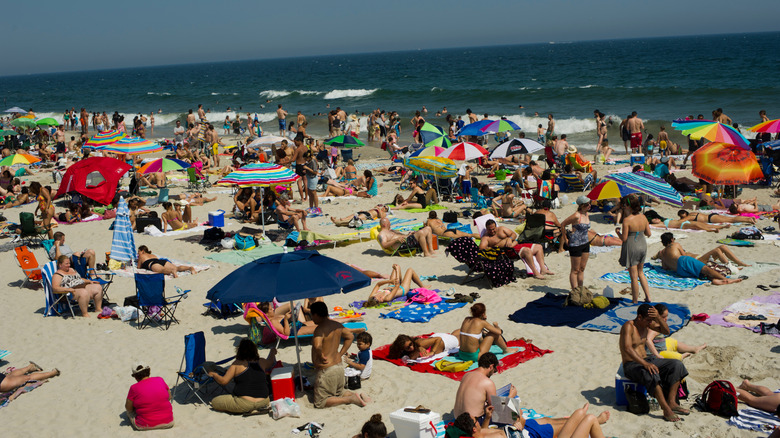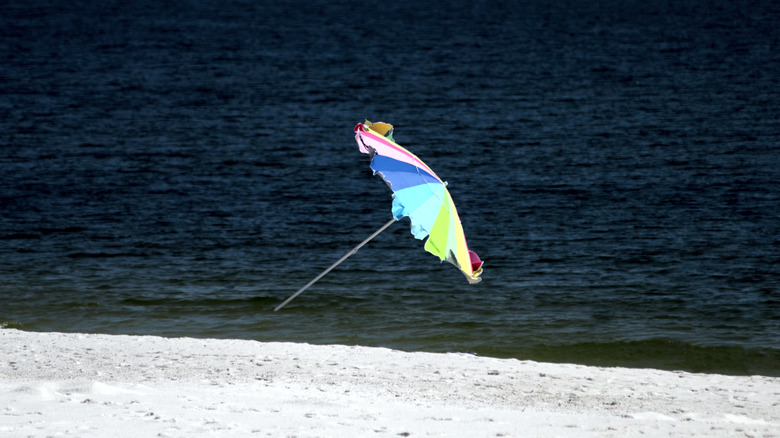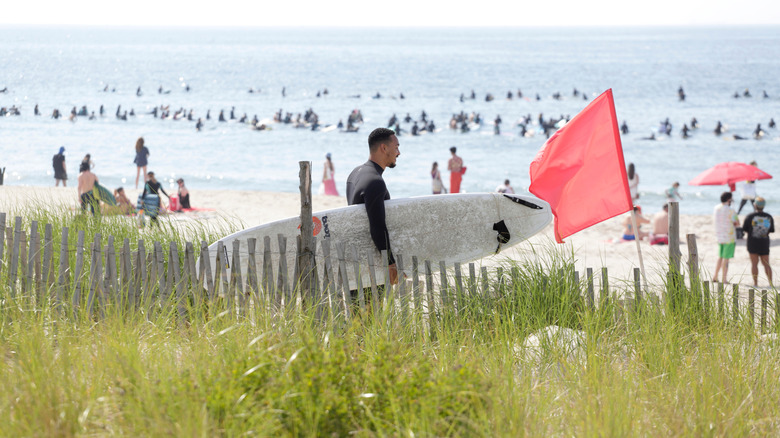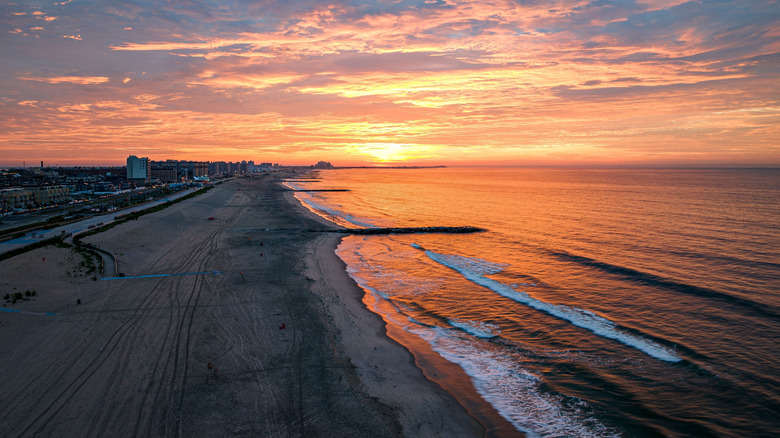Etiquette Rules Locals Wish You'd Follow While Visiting New York City's Crowded Swim Beach
When people think of New York City, they probably think of Broadway shows, shopping along Fifth Avenue, spending the day in Central Park, or dancing the night away thanks to the city's thriving nightlife. Many people might even assume that if you want to really spend some time in nature, you would have to leave the city entirely, right? Wrong. You can easily take a break from city life at one of New York's most popular beaches: Rockaway Beach. You just need to learn how to "beach" like a New Yorker, including knowing the local beach etiquette.
While Rockaway Beach, also called the Rockaways, is not the only city beach (Brighton Beach and Coney Island also get their fair share of beachgoers, as do other smaller beaches). But as a New Yorker, I can attest that the Rockaways offer a local, small beach-town feel while also being easily accessible from the heart of the city. You can take a shuttle bus or the NYC Subway A train, but the best way to get there is by ferry, which picks up in both Lower Manhattan and Sunset Park (Brooklyn). This way is a bit slower, but it saves you a sweaty, long trip on the subway –– plus you'll get a view of the Statue of Liberty in the distance.
But before you go to this supremely underrated NYC tourist attraction, you might want to prepare yourself. Going to a city beach is not like going to less crowded beaches elsewhere. You still have to experience communal, urban living because this beach is wildly popular with both visitors and locals alike. Here are some of the unspoken etiquette rules you need to know.
Respect of your neighbor's space (in more ways than one)
Just so you know, your beach day begins once you're in transit. Whether you're navigating New York City's subway system or taking the ferry to Rockaway Beach, make sure you're not crowding people around you with all your stuff. Once you're there, be mindful of how many people you have with you. It may not be a big deal to set up in front of someone when it's just you, but if you have a big party with you, be sure to pick a spot that doesn't feel like you're spilling into someone else's area or blocking their view of the ocean. Leave a few feet, if you can, between your area and someone else's. Everyone understands that it's going to be crowded, but being self-aware of personal space is also greatly appreciated. This is especially true if you plan on playing music or playing a game. Other people may not appreciate your volleyball getting punted into their area or have the same musical taste as you. If you bring a speaker, make sure it's set at a reasonable volume and give yourself a wide berth for throwing frisbees. It's also important to keep in mind that pets are not allowed at Rockaway Beach during the summer season.
And speaking of noise, if you're in a group that has no filter and has trouble keeping a lid on using curse words or talking about (or in rare cases, doing) something risqué, try to keep the conversation at a low volume or be aware of any kids in your area. This is also important if you need to change your clothes as well: There are bathrooms at the beach, or you can just come in your swimsuit so as to avoid any wardrobe malfunctions.
Secure your spot (but don't try to sneak a beach chair)
Just like trying to save spots and beach loungers is a costly mistake travelers make on beaches in Spain, you should assume that anything you did not personally bring to the Rockaways is off limits. Most locals, especially ones without cars, lug their own beach gear in New York City (yes, subway and all), so most of the chairs and umbrellas you'll see on the beach are someone's personal property. If you're just visiting and didn't bring that stuff in your suitcase, you can also rent beach chairs and umbrellas through local vendors like Beach Tripper, Boarders Surf Shop (near Beach 92nd or Beach 97th), or Rockaway Bazaar, which you can reserve via the email listed on their website. If you see a bunch of the same chair set up on the sand in a grid, just know that those are rentals and not for public use.
But securing your spot isn't just about picking a place that is not encroaching on someone else's spot. It's also about being mindful of the weather, especially wind. Far Rockaway and Rockaway Park are major spots for kitesurfing and windsurfing, so you may get your fair share of breezy weather while you're there, depending on the weather that day. Be sure to secure your beach umbrella, towels, picnic blankets, and chairs so nothing goes flying into someone else's area. Most people will keep their chairs and towels weighted down with their beach bags and other belongings, but your umbrella should be firmly secured in the sand. To make sure it's deep enough, rock the pole back and forth into the sand until it is about a third of the way buried instead of just sticking it straight down.
Be aware of surfers and stay off the rock jetties
Let's talk about personal safety for a second. The waves at Rockaway Beach can be fairly intense, depending on the weather and time of day that you visit, so it's important to know that you should never swim alone and should only go in the water if there is a lifeguard on duty, which is between 10 a.m. and 6 p.m. daily during the summer. Areas that do not allow swimming are marked by red flags.
In addition, there are certain parts of the Rockaways that are specifically for surfers, and while you are welcome to watch them safely from the sand, you're not allowed to swim in these areas because there are no lifeguards –– and you don't want to get in the way of someone's surfboard, potentially risking both your lives. Surf beaches are found between Beach 66th Street to Beach 70th Street, Beach 87th Street to Beach 92nd Street, and Beach 110th Street to Beach 111th Street.
In addition, once you're down at the beach, you might notice that there are strips of large rocks that jut out into the ocean from the beach. These are rock jetties, and they were built to reinforce the beach after Hurricane Sandy (and coincidentally create better waves for surfing). As tempting as it might be to try to play on the rocks or try to snag a good picture on them, they are very slippery and not meant for people to climb on. Even if you tried (which is risky and not advised), you'll be met with a lifeguard's whistle ... and maybe some choice words. Climbing on the jetty will also get you fined.
Do not feed the seagulls ever
This may seem like a no-brainer. After all, anyone who has been to a zoo can see that you shouldn't feed the wildlife. Anecdotally, many New Yorkers can confirm that the seagulls at Rockaway Beach are a bit aggressive. They're not afraid of humans, and it's not unheard of that a seagull might try to get into your beach bags if you're not watching, especially if there's food in them. The added expectation that "where there are humans, there is food" also means that seagulls try more intense tactics, including swarming in places where they don't belong. Not only can seagulls be annoying to beachgoers, but they can also carry diseases like salmonella, which can make someone very sick if they come into contact with it.
In addition, the increase of seagulls on the beach also means that you and your fellow beachgoers will have to deal with the constant squawking and noise that they make –– which could really put a damper on the day. Plus, more birds mean there's more bird excrement around, which is not only gross but can also spread diseases even after the bird is gone. But beyond that, feeding the gulls is also bad for them. Seagulls and other wildlife that come to rely on humans feeding them could suffer from poor nutrition, which is bad for their general health. Plus, if they swarm in high-traffic areas, they could get hit by cars.
Leave no trace at the end of the day
Just like in national parks and recreation areas, New Yorkers will thank you not to litter. Plastic bottles, spent bags of chips, empty food containers –– all these things can destroy the delicate ecosystem, end up in waterways, and just generally make the beach unpleasant. Yes, there are garbage bins around, but even if they're full, it's courteous to just take your trash with you until you can find an appropriate place to dispose of it. Volunteers have cleaned up more than 1 million pounds of trash since 2013 (via CBS News), which is a staggering amount and all the more reason to show your appreciation for their efforts by not contributing to the trash pile.
But beyond trash, you should also make sure your environment when you leave looks just as you found it (or better). Don't leave behind big holes from sandcastle-building or your beach umbrella, especially since someone else might want to use that space later or, more importantly, might accidentally trip and hurt themselves if they're not paying attention.
